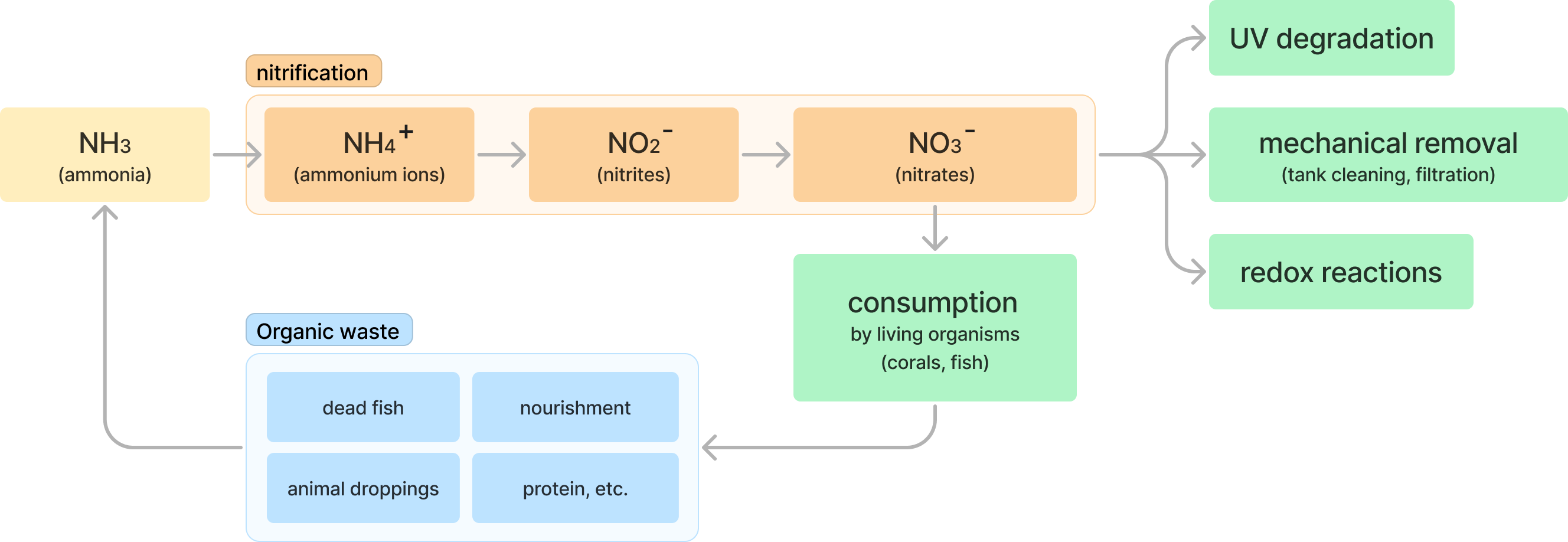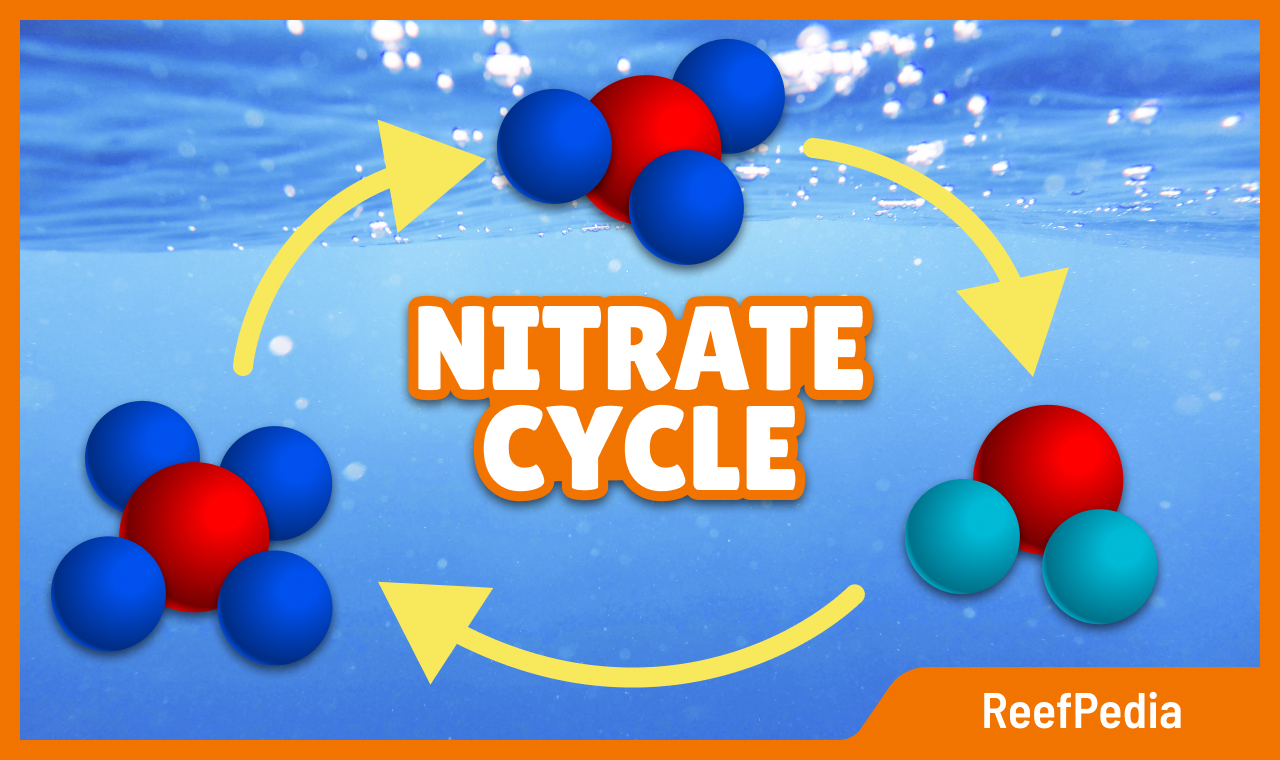Table of Contents
The importance of nitrogen (N) for living organisms
Nitrogen is one of the biogenic elements, making it essential for the formation of organic compounds used in the construction of living organisms, such as amino acids, nucleic acids (RNA and DNA), ATP, and NAD/NADP.
Biogenic elements participate in various life processes:
- cell structure,
- transmission of nerve signals,
- metabolic processes,
- photosynthesis process,
- and many others.
For living organisms, maintaining proper proportions and quantities of biogenic elements is essential because deficiencies or excesses can lead to various metabolic and health disorders.
What is the nitrogen cycle
The nitrogen cycle is a biological process in which nitrogen circulates among the atmosphere, soil, water, and living organisms. It is a complex cycle that involves various stages of nitrogen transformations, both in gaseous form and as chemical compounds that are assimilated by organisms. The nitrogen cycle enables organisms to acquire nitrogen in forms that are absorbable and useful to them.

The importance of nitrogen in aquariums
In marine aquariums, it is crucial to maintain the proper environment for biogenic elements such as nitrogen. Appropriate proportions and quantities of biogenic elements play a key role in maintaining the health of animals. Nitrogen affects various aspects in marine aquariums; below, I have listed a few of them:
Properly balanced water parameters
A marine aquarium requires the maintenance of stable parameters, one of which is the level of ammonia, nitrites, nitrates, and others.
The process of photosynthesis
Biogenic elements are crucial for the process of photosynthesis, which occurs in symbiotic algae (zooxanthellae) living in coral tissues. Nitrogen, although not directly involved in this process, does impact the overall health of corals and their symbiotic algae. Therefore, it is considered that nitrogen indirectly influences the ability to photosynthesize.
Algae growth control
Nitrogen in the environment exists in many different forms, and each of them can be utilized by various microorganisms. Proper proportions of nutrients in a marine aquarium, including nitrogen compounds, are crucial in preventing excessive algae growth, which can negatively impact water quality and the health of fish and other organisms.
The role of bacteria in the nitrogen cycle
Microorganisms, including bacteria, play various roles in the nitrogen cycle:
- They secrete enzymes that are involved in individual stages of the nitrogen cycle
- They assimilate nitrogen to build their own proteins
- They live everywhere in the aquarium, but there are many more of them in sediments and on rocks than in the water column. Depending on the place – whether it is the water column, the surface or the inside of a rock – a different amount of oxygen reaches microorganisms, which affects what species we are dealing with.
Stages of the nitrogen cycle
The nitrogen cycle cycle consists of several stages:
Ammonification
It’s a process in which organic substances containing nitrogen (pollutants, proteins, etc.) are broken down by microorganisms into ammonia. Additionally, marine animals in our tanks eliminate toxic compounds from their bodies in the form of ammonia, which is harmful to organisms, especially at a pH above 7. Other sources of ammonia in tanks include food remnants, dead organisms, or proteins released by microorganisms.
Bacteria, often found in sediments, break down these substances into ammonia through a process called ammonification. In the initial oxidation of ammonia, bacteria such as ammonia-oxidizing bacteria (AOB) from Betaproteobacteria (e.g., Nitrosomonas spp.) or Gammaproteobacteria (e.g., Nitrosococcus spp.) are involved, as well as ammonia-oxidizing archaea (AOA) from the Thaumarchaeota genus (e.g., Nitrosopumilus maritimus).
Nitrification
During the nitrification process, ammonia is oxidized into nitrites, and then nitrites are converted into nitrates. During nitrogen assimilation, microorganisms transform nitrates and ammonium ions into complex organic molecules, building their own cells.
Inorganic compounds like ammonia (NH3), ammonium ion (NH4+), and nitrite (NO2–) are important substrates for chemolithotrophs, which are bacteria that use inorganic compounds for energy and utilize CO2 as a carbon source.
In the first stage of nitrification (1), ammonium ions (NH4+) are oxidized, involving bacteria like Nitrosomonas, which convert ammonia into nitrites (NO2–). This reaction involves ammonia monooxygenase, simultaneously producing an intermediate compound – hydroxylamine (NH2OH), which is further oxidized to nitrites with the help of hydroxylamine oxidoreductase.
NH4+ + 2H2O → NO2– + 8H+ + 6e– (1)
In the next stage (2), nitrite is oxidized by nitrite-oxidizing bacteria (NOB), which belong to various types such as Nitrospirae (e.g., Nitrospira spp.), Deltaproteobacteria (e.g., Nitrospina spp.), Alphaproteobacteria (e.g., Nitrobacter spp.), and Gammaproteobacteria (e.g., Nitrococcus spp.). Nitrobacter and Nitrospira bacteria oxidize nitrites (NO2–) into nitrates (NO3–), which are less toxic to living organisms. Nitrites are oxidized by an enzyme called nitrite oxidoreductase.
NO2– + 2H2O → NO3– + 2H+ + 2e– (2)
Assimilation
Nitrate assimilation is a process in which bacteria utilize nitrates and ammonium ions as a nitrogen source, synthesizing them into organic nitrogen. Microorganisms responsible for this process are found in water and sediments. Nitrogen, an essential cell component, is retained in the cells, constituting about 12% of the dry cell mass. In this case, nitrogen is often removed from the tank along with bacterial and algal sediment.
Nitrates are the primary nitrogen source for protists, fungi, bacteria, and archaea. Nitrate reductases, enzymes present in the cytoplasm, and ATP-dependent transporters (adenosine-5′-triphosphate – the main energy carrier in cells) in their membranes participate in the assimilation process. Phytoplankton primarily assimilates ammonia as a nitrogen source needed for cell growth, competing for available ammonia with heterotrophic microorganisms.
Denitrification and anammox
Denitrification and anammox are processes that break down nitrogen compounds into molecular nitrogen. Bacteria with the enzyme nitrogenase bind molecular nitrogen with hydrogen, leading to the formation of ammonia. This cycle constantly occurs not only in marine aquariums but also in various environments in water and on land.
Denitrification is a process that occurs in anaerobic conditions. Most denitrifiers belong to Proteobacteria, which are facultative anaerobes. They possess a series of enzymes that enable them to utilize nitrates in the absence of oxygen. The final stage of this process is the release of gaseous nitrogen.
Stages of the denitrification process:
In the first stage, the reaction is catalyzed by nitrate reductase A and B
3NO3– + 6H+ → 3NO2– + 3H2O (3)
The second stage of the denitrification pathway is the reduction of nitrates(III) to N2.
2NO2– + 8H+ + 6e– → N2 + 4H2O (4)
Anammox is the process of anaerobic oxidation of ammonia. There is another group of bacteria that can convert urea and nitrites into gaseous nitrogen in a process called anammox (anaerobic ammonia oxidation). The anaerobic ammonia oxidation process is regulated by Planctomycetes bacteria, which use nitrites (NO2–) or nitrates (NO3–) as electron acceptors (an acceptor – a molecule, a single atom, or an ion that accepts electrons, protons, a functional group, or a specific ion from other molecules during a chemical reaction).
In this case, oxidation involves the flow of electrons through the chain of carriers (cytochromes) to enzymes oxidizing nitrate ions (III) to atmospheric nitrogen. The execution of this process depends on specialized cell structures with a membrane protecting the cytoplasm from hydrazine. This leads to a very rapid breakdown of nitrogen compounds in the marine environment.
Summary
In marine aquariums, controlling the nitrogen cycle, regular water testing, and understanding various biogenic processes are essential for maintaining a healthy aquarium environment. The nitrogen cycle enables organisms to acquire nitrogen in forms that are absorbable and useful to them. Nitrogen, being one of the biogenic elements, plays a crucial role in the life of living organisms.
*Archaea – prokaryotes similar to bacteria but differing in many aspects, such as cellular structure and genetics.
About Author

Agata Łobocka
I’m an industrial biotechnologist by education. I’m fascinated by microbiology and the influence of the microworld on everything that surrounds us. Professionally, I create products based on microorganisms that are more environmentally friendly than classic, popular preparations.
Before I started my adventure at Reef Factory, I was widely interested in freshwater aquaristics. In the world of marine aquaristics, I was most fascinated by the huge network of dependencies created by corals with their symbiotic microorganisms. These relationships perfectly show that organisms need their microfriends to function in health, and every element of this relationship benefits from it.
Privately, I’m interested in new technologies that counteract the negative impact of man on the environment. I'm also into self-development, cognitive science and popular science literature. I like to spend my free time actively, surrounded by beautiful nature.
I hope that my articles from the Biology section o ReefPedia will help you better understand the life in a marine aquarium.

